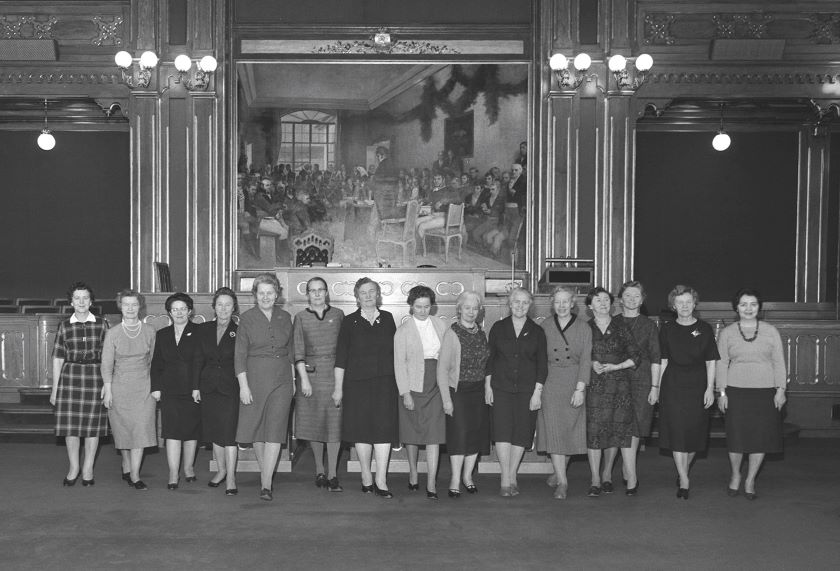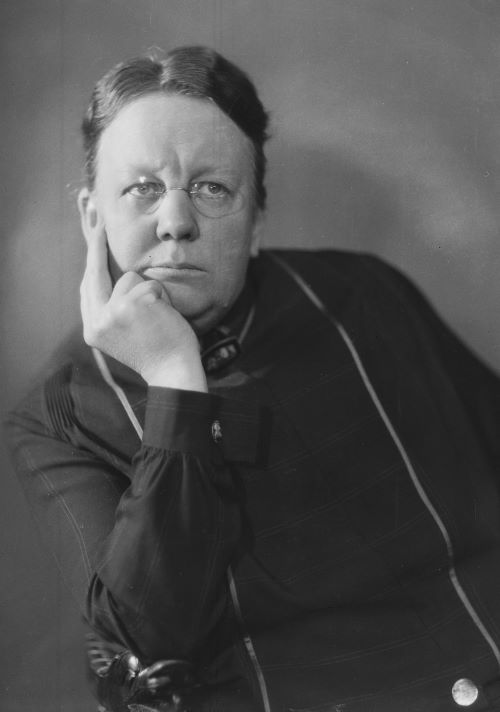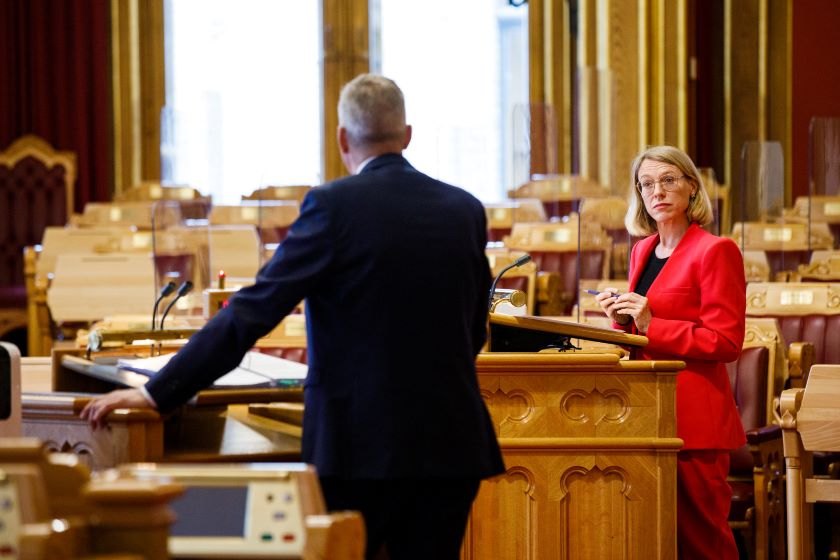
Female MPs in 1962. (Left to right) Guri Johannessen (Labour Party), Rakel Seweriin (Labour), Hanna Berg Angell (Labour), Berte Rognerud (Conservative Party), Martha Johannessen (Labour), Magnhild Hagelia (Labour), Liv Tomter (Labour), Jenny Lund (Labour), Gunvor Eker (Labour), Karen Grønn-Hagen (Centre Party), Haldis Tjernsberg (Labour), Sunniva Hakestad Møller (Labour), Margit Tøsdal (Labour), Aase Lionæs (Labour) og Margit Munkebye (Labour). Photo: NTB.
A century of female representation
In 2021, we are celebrating the fact that it is 100 years since Karen Platou (Conservative Party) was the first woman to be elected to the Storting as a regular MP. Platou’s election was a milestone for Norwegian democracy.
The centenary celebrations have provided the opportunity to commemorate the female pioneers who have stood at the forefront of women’s participation in democracy. It is also a reminder that the battle for representation and democracy does not end merely when rules are changed and rights formally granted.
The story of female representation in the Storting is about small steps on the road to major change. From the fight for female suffrage at the end of the 19th Century to today’s situation, where it is a given that women can hold any position of power in Norwegian politics.
Karen Platou – a pioneer
Karen Platou was elected as a regular MP in 1921. This was 14 years after many women were first given the vote and ten years after Anna Rogstad had become the first woman to meet in the Storting as a Substitute MP. The 1921 parliamentary election was the fifth at which a limited number of women were able to vote and thereby to stand for election.

Karen Platou was elected as a regular MP in 1922-24. She was also a Substitute MP from 1919-21 and 1925-27. Photo: Anders Beer Wilse / National Library of Norway.
Platou represented the Conservative Party, was a qualified architect, an active businesswoman, and was instrumental in the work of several associations and societies. Among these, she was a driving force in Oslo Hjemmenes Vel, a conservative homemakers’ association. She was also a tireless participant in the social public debate and a public speaker both before and after her time in the Storting. As an MP and a member of the Justice Committee, she was active in such issues as housing, social affairs and women’s rights.
Small steps to major change
Although the election of Platou broke fresh ground, until World War Two few women were to follow in her footsteps. The next woman to become a regular MP was Helga Karlsen (Labour Party), who was elected in 1927. Four more women followed in the 1930s. The peak of female representation that decade came in 1933, when three out of 150 regular MPs were women. After World War Two, however, the proportion of female MPs was to rise slowly but surely. Yet it wasn’t until the 1970s that women accounted for one in ten of the MPs in the Storting, and not until 1985 that a quarter of MPs were women.
Political positions of power
During the post-war era, an increasing number of women were to assume important parliamentary posts. In 1945 Claudia Olsen (Conservative Party) became the first female chair of one of the Storting’s standing committees. This was such an unusual occurrence that it took forty years until the name komitéformann (“committee chairman”) was officially changed to komitéleder (“committee chair”). The 1981-85 parliamentary term was the first at which there was more than a single female committee chair.
The Storting’s political leadership also remained a male bastion for much of the last century. The first woman to preside over a sitting in the Storting was Magnhild Hagelia (Labour Party), who became a substitute President of the Lagting in 1961. The Presidium’s first female member was elected four years later, when Aase Lionæs (Labour Party) became the Vice President of the Lagting. In 1973, Torild Skard from the Socialist Electoral League, a forerunner of the Socialist Left Party, was elected as President of the Lagting. And it took a further twenty years until a woman became Norway’s foremost representative of the people, when Kirsti Kolle Grøndahl (Labour Party) was elected President of the Storting in 1993.
Records to break
The proportion of female MPs during the 2017–2021 parliamentary term was almost 41%. In addition, for the first time in history, all three branches of the state were led by women. A century after Karen Platou’s election, the results of the 2021 parliamentary election led to a further rise. 76 women – almost 45% of the total number of seats – were elected to the Storting, the highest ever.
As we celebrate 100 years of female representation in the Storting, it is plain to see that the road from gaining rights to the point at which these rights actually work in practice can be long and winding. Even after the initial battles have been won.

The final Question Time of the 2020-21 session. Anniken Huitfeldt (Labour) and the then Minister of Defence, Frank Bakke-Jensen (Conservative Party). Photo: Storting.
Last updated: 08.12.2021 09:20